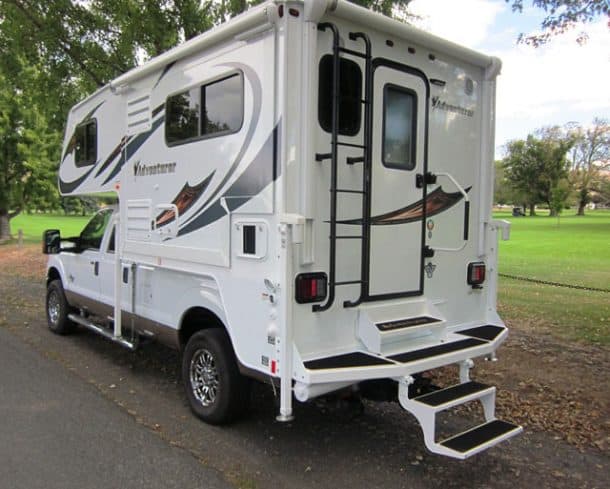Truck Camper Magazine examines the importance of mobility in current and future truck camper design. With 85 million Baby Boomers in the USA and Canada, this topic requires more industry attention.

Every year for almost a decade, Truck Camper Magazine’s readership has grown in numbers, and has become a little older. On balance, we are attracting more younger readers, but the overwhelming majority of our readership (over 71-percent) belongs to the baby boomer generation (born 1946-1964).
Having a simultaneously growing and aging readership is both a fantastic opportunity, and a concern. On one hand, Truck Camper Magazine is effectively reaching the most valuable demographic in history. Even better, retired and retiring baby boomers should be in the driver’s seat – literally and figuratively – for at least the next 20 years. Sales managers and marketing directors rejoice.
On the other hand, our aging readership is also a sign that we need to work harder at reaching a younger audience if this magazine – and the truck camper industry in general – is going to continue to thrive past 2035.
This isn’t a problem exclusive to the truck camper industry. The greater RV industry, not to mention almost every non-digital hobby you can think of, is looking into the face of extinction after the baby boomer generation. Even the golf industry is struggling to successfully attract the next generation away from their laptops and smartphones.
Fortunately, the opportunity the baby boomer generation represents is unprecedented. While the truck camper industry should not ignore younger demographics, it would be fool hardy not to focus the majority of the product design, marketing, and sales efforts on the 85 million baby boomers in the United States and Canada currently between the ages of 52 and 70. Unlike any other demographic, they have the numbers, they have the interest, and they have the means.
What Does This Mean For Truck Camper Design?
We have met and talked with thousands of fellow truck campers from coast-to-coast. Per our readership demographics, most of the truck camping folks we meet are baby boomers.
Whether it’s a casual conversation between campsites, or a sit-down pow-wow around a campfire, the topics that come up, and the exchange that follows informs everything we do at Truck Camper Magazine.
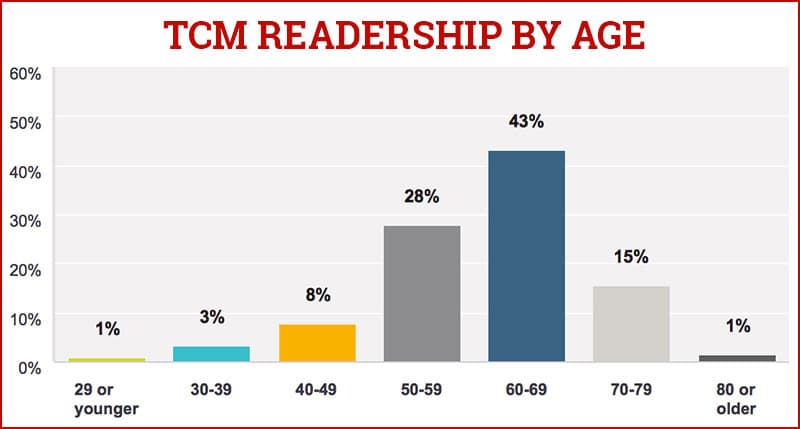
In these conversations, one of the most repeated subjects is mobility. Specifically, the ability to move about a truck camper safely and in comfort as their flexibility, steadiness, and strength diminishes over time.
To be clear, many truck camper owners have yet to experience these symptoms, or haven’t been slowed down by them yet. However, they are thinking about this eventuality, a concern often triggered by caring for their elderly parents.
Most of their concerns are centered around the entry step system and the cabover entry way. In short, they wish the industry would take their mobility changes to heart and design their entry step systems and the cabover entry ways to be both safer and more comfortable.
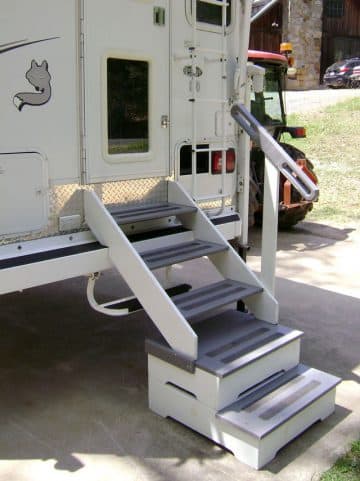 | 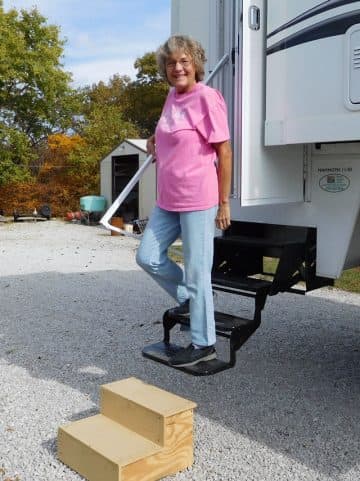 |
Above: Steps and banister on rear entry camper – Denis Senecal, 2014 Mod Contest, steps and banister on side-entry camper – David Thompson from February 2016 Mod Contest
Perhaps the most obvious sign that mobility is a priority for truck camper owners is the sheer quantity of mobility-focused modifications submitted to our monthly mod contests.
It’s routine to have improved camper step systems, deep bumper set-ups, comfort-improving dinette re-configurations, and even cabover assist handles submitted for the contests. Perhaps an even bigger tip is that these mobility modifications earn a lot of votes, and have won multiple times.
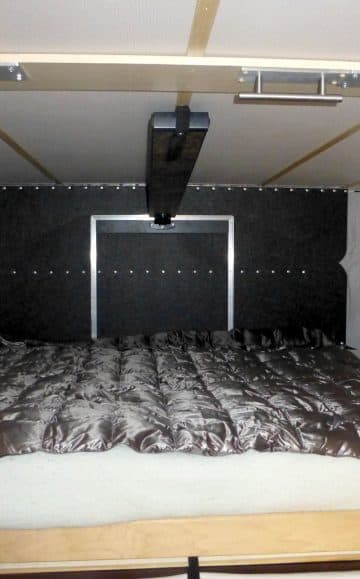 | 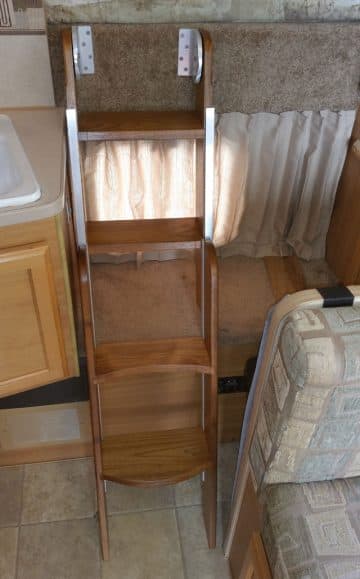 |
Above: Grab handle on ceiling – Bill Harr from May 2016 Mod Contest, ladder to overcab – Vern and Tracy Mowrey from January 2016 Mod Contest
Before anyone in the industry dismisses these concerns, consider this; the mobility-challenged truck camper owners we talk to are often considering something other than a truck camper. They are deeply concerned about falls from their truck camper, but do not want to give up their traveling lifestyle.
Put bluntly, if the truck camper industry ignores the growing importance of mobility, many life-long truck camper owners will buy small mobility-friendly motorhomes. We are already starting to see this happen.
Mobility Challenge 1: Camper Entry Step Systems
Over the past few years, the truck camper industry has made overtures toward more mobility-friendly products. For example, the introduction of deeper and wider aluminum rear bumper systems with deeper and wider steps.
Above: Examples of bumper step systems that improve mobility; Northern Lite’s aluminum folding bumper step, Northwood Manufacturing’s Fox Landing, Adventurer Manufacturing’s Comfort Step, and Lance Camper’s Ultra Deck Plus
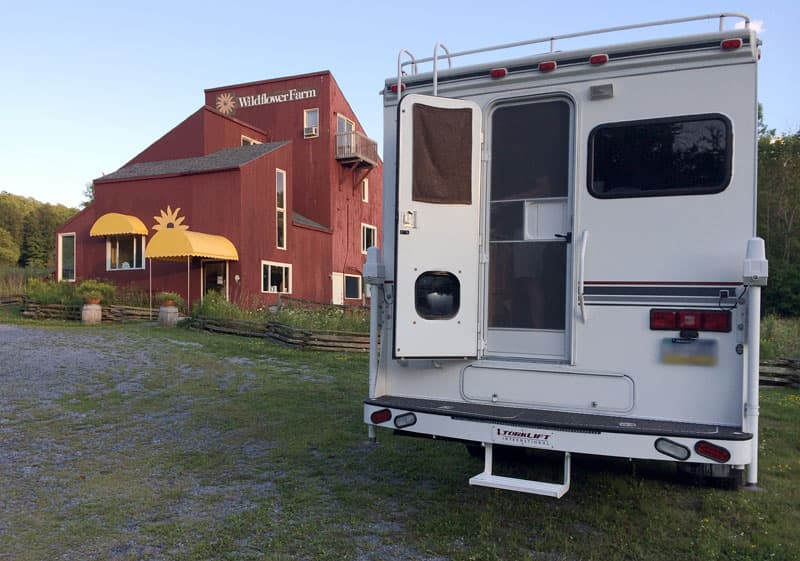
Above: Our camper with a prototype Torklift International bumper and step, a system based on the Palomino Landing Pad
We may only be in our early 40s, but we absolutely love the improved safety and comfort of our prototype Torklift International bumper system and steps. It truly is safer and more comfortable than the steep and shallow factory-original bumper and step.
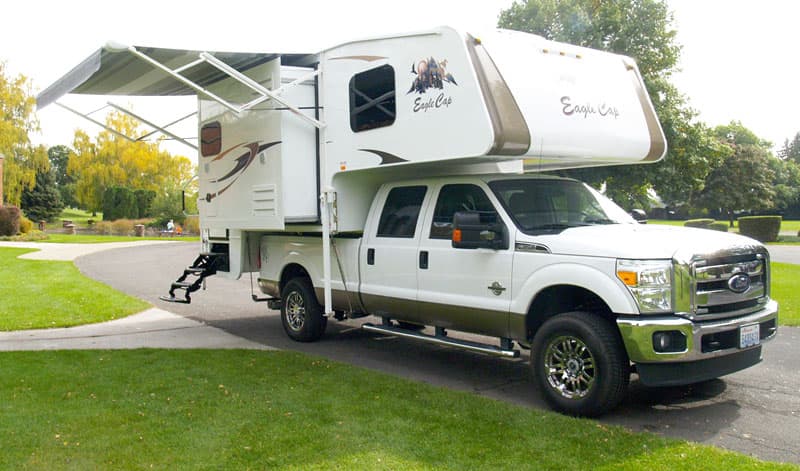
Above: Side entry steps on an Eagle Cap triple-slide
Rail-height multi-slides have implemented side-entry floor plans with residential-height pull-out steps. In theory, a side-entry design lowers the entry point closer to the ground, and the residential-height pull-out steps make climbing into the camper safer and more comfortable.
In reality, the steps on rear-entry and side-entry truck campers rarely, if ever, come down far enough. When mounted on a truck, rail-height side-entry campers are infamous for leaving two feet of air from the ground to the first step. It’s not unusual for folks to use a 2-step step stool to solve this problem.
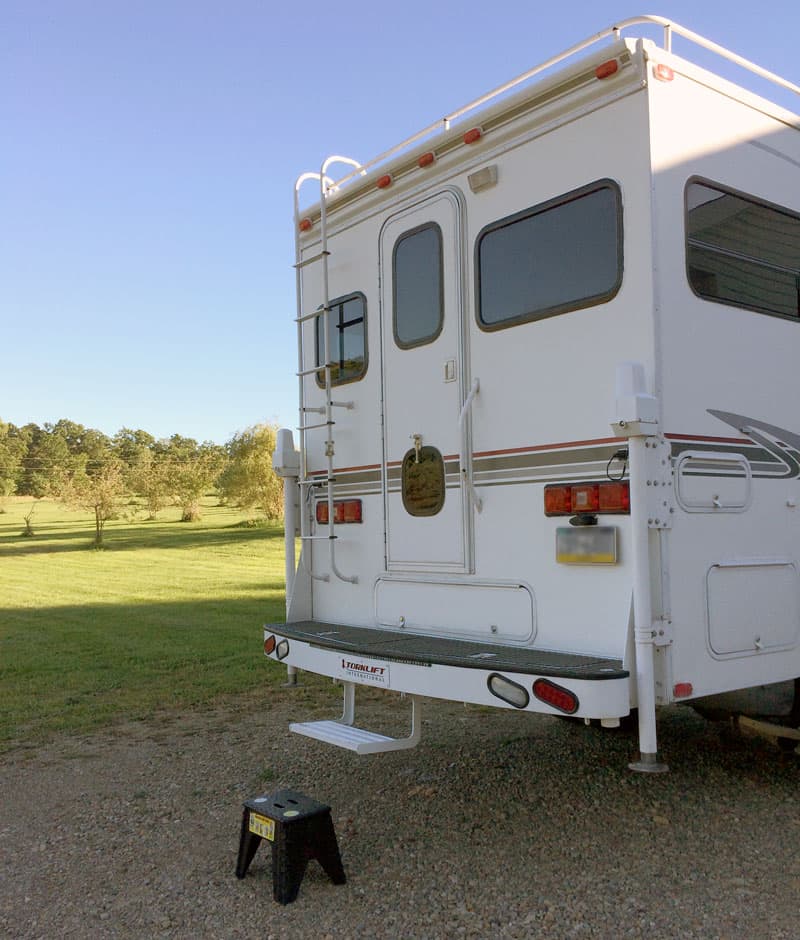
Above: Step stools are required for most truck camper rigs – including ours
Rear entry step systems have improved but, even with the new bumper step systems, they usually leave too much distance between the ground and that first step. How often do you see a rear-entry truck camper with a step stool under the entry steps? Almost always.
Proper assist handles are another opportunity for improvement. As of now, manufacturers don’t typically offer assist handles that extend far enough out or down enough to safely and comfortably guide folks up and down the entry steps.
Mobility Challenge 2: Cabover Bedroom Entry and Exit
The other mobility challenged area of a truck camper is the cabover entry point. Thankfully, the industry has made some advancements here as well.
First, multi-slide truck campers with rail-height floors have significantly lowered the cabover bedroom’s entry height. For many rail-height campers, you can literally sit into the cabover, and then crawl into bed – no climbing necessary. We know several rail-height camper buyers who cited this feature as an important reason for purchasing their camper.
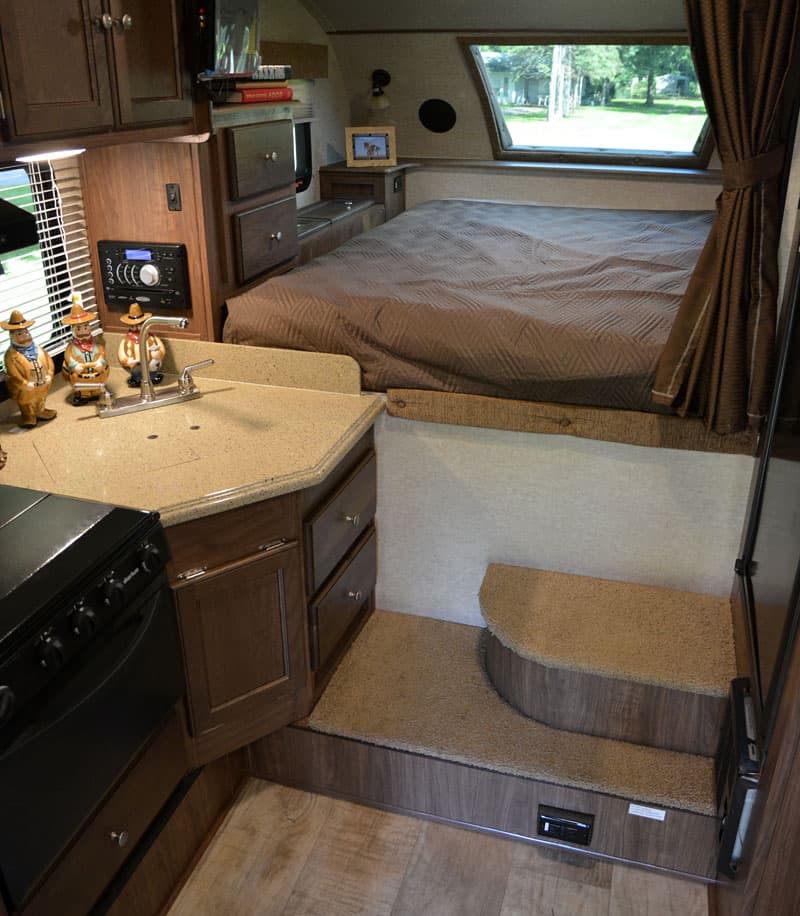
Above: Cabover steps in the Palomino HS-2910
Second, many campers with wheel-well height basements have implemented more and better stepping points to aid cabover entry and exit. These stepping-points are often wider and deeper than they have been in the past. This solution is not as comfortable as rail-height cabover entry, but it’s a lot better than the cabover leap some truck campers present.
Better cabover stepping-points are great, but how about cabover grab handles to help folks carefully pull themselves into the cabover, lower themselves down from the cabover, and stabilize their cabover ascent and decent? Wider and deeper cabover stepping-points and cabover grab handles should be considered for all truck camper designs, even pop-up campers.
The Mobility Solution
With truck camper consumers growing in number, and getting older, there’s no escaping the importance of embracing mobility for current and future truck camper designs.
I strongly believe mobility is now as important as customer service, quality control, serviceability, and overall floor plan and feature appeal. If the industry embraces this fact, and designs, builds, and promotes effective mobility solutions, they will be rewarded with even stronger sales.
I also don’t believe the challenge of building mobility-friendly truck campers is that complicated. First, the problems are primarily centered on the entry and exit from the camper and cabover. Address these issues and your campers will be well on their way.
Second, there’s an entire industry focused on making homes and automobiles mobility-friendly. Study their resources, hire their consultants, and adopt their practices. For further inspiration and ideas, bring one of your truck campers to a rally and ask the attendees for feedback on mobility. What you’ll learn will be invaluable.
As a magazine, we are going to start asking manufacturers about mobility when they announce new campers and model year updates. This article is their fair warning, and I’m sure many of them will take full advantage of the topic. After all, we’re talking about the real world concerns of their potential customers. Wouldn’t it be great if manufacturers began talking about mobility in the same way they now talk about floor space, new features, and updated interior decors?
Finally, we also believe that truly mobility friendly truck camper design could all but prevent long-time truck campers from defecting to motorhomes, or worse; prematurely hanging up their keys. It may shock some, but we have recommended motorhomes to truck camper owners who can no longer safely make the climb into their camper or cabover. It’s better to have them in a motorhome than give up, stay home, and miss all their friends and fun. After all, that’s what this is all about.
TCM’s First Special Report
This article is part of a new Special Report series that will focus on important topics that don’t normally get a spotlight in Truck Camper Magazine. We chose mobility as our first topic, and look forward to tackling more important topics in the future.
Just as we allow manufacturer responses to published reviews, we invite industry leaders to respond to this Special Report. All manufacturer responses will be published immediately, featured in the next Email Alert, and linked to from this article.
Readers are also invited to respond through this week’s mobility poll. Click here to read the reader responses from our mobility poll.








